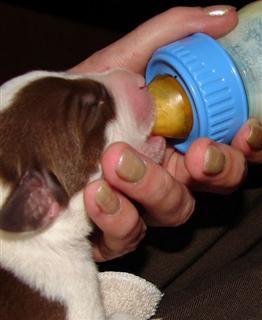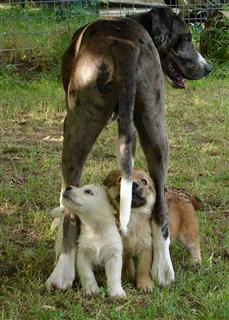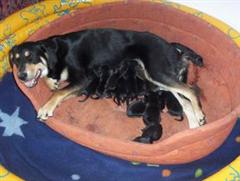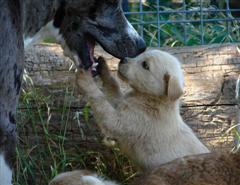Pregnant and lactating dogs may need to be fed puppy chow to give them the necessary protein. Sick, weak, and debilitated animals also need extra protein. Animals with kidney disease may need to be on a protein-restricted, but high biological value diet to lessen the effects of the kidney disease.
Can I feed too much protein?
The answer to this is yes and no. In theory, if a healthy animal eats too much protein, some gets excreted in the urine and the rest just gets used as calories or is converted to fat and does not cause any harm. If you dog has a kidney problem, however, high protein diets are not recommended. The other factor is that next to marketing, protein is the most expensive ingredient in the food and why pay for more than you need. Most pet food companies strike a happy medium and meet the minimum recommended requirements and add a little extra to be safe.
Proteins are the building blocks in animal nutrition. They are one of the most important nutrients in the diet and are currently one of the most widely debated. For around twenty thousand years as dogs, and for several million years before that as wolves, the only problem canines had with protein was getting enough of it. Dogs ate a primarily meat diet and with that consumed a high percentage of their diet as protein. With their meat diet they also got a fair portion of fat and a little fiber and carbohydrate thrown in, but primarily they ate meat. Cats were pretty much the same only they were even stricter carnivores and did not eat any carbohydrates.
Amino acids
Why do dogs and cats need protein? Proteins are necessary for all aspects of growth and development and are very important in structural make up and the immune system. In addition, they are burned as calories and can be converted to and stored as fat.
In reality, our pets do not need the protein but they need the building blocks that make up the protein, amino acids. There are 22 amino acids that animals need. Animals can synthesize 12 of them. The remaining ones must be consumed. The ones that the animals cannot synthesize are called essential amino acids. They are arginine, histidine, isoleucine, leucine, lysine, methionine, phenylalanine, threonine, tryptophan, valine, and in cats, taurine. Dogs can synthesize taurine, and therefore, it is not supplemented in their food. This is why there is the old adage that dogs can eat cat food but cats cannot eat dog food. A deficiency in any of the amino acids can cause health-related problems.
Protein quality
Every protein source contains different levels of amino acids and each protein is different in its ability to be broken down into amino acids. So not all proteins are created equal. Some are better for pets than others. The ability of a protein to be used by the body and its amount of usable amino acids is summarized as protein quality (biological value).
Egg has the highest biological value and sets the standard for which other proteins are judged. Egg has a biological value of 100. Fish meal and milk are close behind with a value of 92. Beef is around 78 and soybean meal is 67. Meat and bone meal and wheat are around 50 and corn is 45. Things like hair and feathers would be very high in protein but would be down at the bottom of the list for biological value. The actual composition of individual proteins as well as the utilization of amino acids is very detailed and beyond the scope of this article, but in summary, we see that all proteins are not created equal.
Interpreting the pet food label
This is where the hard part comes in. You now have two choices. The first is to buy a reputable quality brand of dog food for the activity level of your dog and hope that its needs are being met. This is what most owners do and the average dog does just fine. But if you have a dog with special protein needs or want to search out the best possible food for the money then you must dive into the label and try to interpret it.
If you have been reading so far you know that not all proteins are created equal. The listing of protein level on the bag or can is not a listing of the percent of digestible protein, just a listing of percent protein. So we need to know how to interpret the pet food label. We know that in quality foods digestibility is between 70 and 80%. In lesser quality foods the digestibility could drop to 60% or less.
The way to determine the digestibility is not very scientific but is the best we have until the pet food industry begins to list digestibility. By reading the ingredients and noting the order that they appear we can roughly determine the digestibility. The ingredients are listed in order of weight. If the first ingredient is chicken or lamb we can assume it is a good quality protein source.
Chicken by-product or other meat by-products are not as good but acceptable; meat and bone meal are poorer yet. If grains are listed, they are not as digestible sources of protein and contribute heavily toward the carbohydrate load.
It’s safe to take puppies boating as long as the appropriate supplies like food, water, and an animal life jacket are used. Boating safety is a big concern for humans and animals as high temperatures can lead to dehydration.
Blue Buffalo is a brand that contains no poultry by-products, artificial preservatives, corn, wheat or soy products. They have formulas for every stage of your puppy's life.For a more detailed explanation read my article on reading pet food labels.
In my personal experience, some of the highest priced foods are not necessarily the best foods, yet very rarely, are the lowest priced foods of good quality. |
 |
In relation to cost, I generally recommend the upper middle range.
Large and giant breed dogs
How to feed large and giant breed puppies has fueled the current controversy over protein in the diet. In the past, we fed all puppies the same regardless of breed. There have been several studies that indicate feeding the large and giant breed puppies a lower protein and fat diet may reduce the incidence of bone and joint problems including hip dysplasia.
As a result of this research, several of the large pet food manufacturers are producing and marketing foods specifically for large breed puppies. They claim to be lower in fat and protein, have a special blend of calcium and phosphorous, and imply that they reduce bone problems.
While I believe that there may be a link with bone problems and protein, I am not convinced that by feeding one of the newer large breed puppy foods, that bone problems will be significantly reduced. I still believe that large breed puppy bone problems are primarily genetic and inherited.
Another fact that makes me skeptical about the specialty puppy foods is the following information. If you look at the label and ingredients of the number one sold puppy food in the country that is marketed for all breeds of dogs, you see that it is 29% protein and 9% fat.
The protein sources are chicken by-product and grain based and is average in digestibility. If you look at the most popular large breed puppy food sold in America that claims to be lower in protein and fat and formulated for large breed dogs, you see that it is 26% protein and 14% fat and is made up of chicken protein sources which are very digestible.
Due to the differences of digestibility of the protein sources, the total difference in the amount of protein in the two foods is negligible. Within any brand of dog food there is a difference in fat and protein between their large breed brand and their regular puppy food. But if you compare between brands you will see that some large breed foods are higher in protein and fat then many regular puppy foods.
While the principle of lower fat, protein, and calcium levels may be good in theory, I am not sure, that in practice, the newer foods will make a significant difference in the incidence of bone growth problems. The premium large breed puppy foods appear to be of good quality and should do a great job of providing the needed nutrition, but I would not fault the owner of a large breed puppy who fed a more affordable general purpose puppy food. If cost is not a consideration, then the premium large breed formulas would be a good choice, but if you do your homework you can find a good quality general purpose puppy food that will do just as good a job for a lot less money.
Summary
Protein is a very critical part of your dog’s diet. The majority of premium foods do a good job of providing adequate protein sources for the different life cycles of your pet. There are different protein needs for different species and life cycles so feed the correct one. Large breed dogs may have special protein needs but read the labels carefully and make sure you are getting what you pay for.
The Food Philosophy
Why it's Important for Dogs to Follow Commands Before Eating
Domestication means that dogs don’t have to hunt for food, but they still have to work for food.
In the animal world, waiting is a part of who they are. Dogs have to wait to eat; they don’t just get a meal by Federal Express.
Domestication means that dogs don’t have to hunt for food, but they still have to work for food. When they’re little, puppies work for food by waiting for their mom. This is a form of psychological exercise, and it’s very important for a healthy state of mind.
I feed many dogs at the same time with no problems. Dogs that show calm-submissive energy get to eat first, and I won’t feed dogs that show negative behaviors such as aggression or nervousness. I wait until these dogs project calm-submissive energy before they get fed, much like their mom or pack leader would do.
Work for Food
Before my dogs eat, I take them for a walk. In this way, I ask my dogs to work for food and water. This is a form of waiting, which is psychological exercise that helps nurture a balanced, happy dog.
Your morning routine - every morning, not just some of the time - should go like this: Project calm-assertive energy before you give your dog affection. Then walk your dog to exercise her body and allow her to explore the world. When you get home, prepare her food. While you fill the bowl, ask your dog to sit. If she sits quietly and projects calm-submissive energy with no negative behaviors, place the bowl of food in front of her.
Some of my clients think this routine sounds rigid. But from your dog’s perspective, it’s how Nature always intended her to live.
Food carries a powerful message in the dog world.
Feeding provides your dog with nutrition and gives you the opportunity to shape your dog’s behavior.
Don’t Miss Out on the Ritual of Feeding
When puppies are little, they wait to be fed by their mother. This waiting is a form of psychological work, and it builds a healthy state of mind. Day after day, this ritual plays out among the pack.
I take my dogs for a walk before I feed them. This form of waiting provides my dogs with psychological work and builds a healthy mind. The walk also promotes a healthy body and allows my dogs to experience the world.
Don’t Reinforce Negative Behaviors When Feeding
Dogs don’t get fed when their mind is excited, nervous, tense or aggressive. They get fed when their mind is calm and submissive, which is what their animal pack leader would require.
Make sure your dog has reached a calm-submissive state before you place the food bowl in front of him. If you feed him when he displays any negative behaviors, such as nervousness or excitement, you will reinforce these behaviors, and I can guarantee that they will reoccur.
Food carries a powerful message in the dog world. Understanding its meaning and consequences will allow you to connect with your dog and help him to lead a happy, balanced life.
Veterinary & Aquatic Services Department, Drs. Foster & Smith, Inc.
Coffman. Comparative Reference Guide to Premium Dog Food. Pig Dog Press. Nashua, NH; 1994.
Lewis, L; Morris, M. Small Animal Clinical Nutrition. Mark Morris Associates. Topeka, KS; 1984.
Palika, L. The Consumers Guide to Dog Food. Macmillan. New York, NY; 1996.
Ralston Purina Company. Nutrition and Management of Dogs and Cats. St. Louis, MO; 1987.





